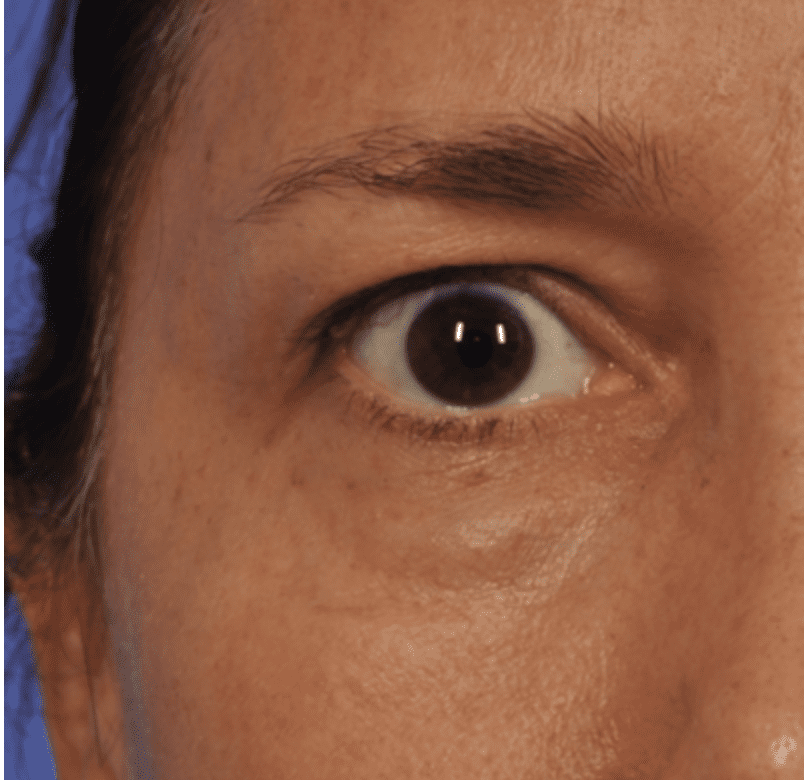
All of Your Common Questions Answered by a Professional
Festoons, those pesky mounds of hanging skin and tissue that appear in the mid-cheek area, are a common concern for many individuals seeking facial rejuvenation. But what exactly are festoons, and how can they be effectively treated?
In this comprehensive guide, we’ll explore exactly what festoons are, their causes, and treatment options. Gain valuable insights from Dr. Allan Wulc, a quadruple-certified plastic and cosmetic surgeon with over 25 years of experience.

Lid retraction—the white showing above the iris.
How Do We Define Festoons?
In architecture, festoons refer to hanging arrangements of flowers, fruit, or lights suspended between two points to form an arc. However, in the context of facial anatomy, festoons are characterized by mounds of hanging skin and associated underlying tissue that appear in the mid-cheek area, seemingly suspended between the inner and outer eyelids.
Unlike the typical lower eyelid puffiness associated with aging, festoons are distinct in their location and appearance, making them difficult to conceal with conventional makeup techniques.
Festoons can either be dry or wet. Dry festoons refer only to overhanging skin, whereas wet festoons represent areas of edema–swelling, and areas where the fullness appears to be full of fluid.
What Causes Festoons?
Several factors can contribute to the development of festoons, including thyroid disease, rosacea, sleep apnea, familial predisposition, and filler or surgery-related complications. Thyroid imbalances and rosacea can lead to inflammation and swelling of the skin, while sleep apnea can exacerbate tissue swelling due to poor oxygenation.
Additionally, genetic factors may predispose certain individuals to develop festoons over time. Furthermore, the improper use of fillers, such as hyaluronic acid-based products like Juvederm or Voluma, can cause hydrophilic-induced edema, worsening the appearance of festoons.

Rosacea—note the red nose and cheeks.

Sleep apnea – exaggerated swelling.

Filler/Surgery Related – Swelling & discoloration.
Are Malar Bags and Festoons the Same Thing?
Malar bags are essentially the same thing as festoons and these terms can be used interchangeably. The malar area refers to the cheek, and edema of the cheek gives rise to swelling at the junction of the lid and the cheek. Festoons are hanging mounds of skin and tissue as well.
How Do We Treat Festoons?
Treatment options for festoons vary depending on the underlying cause. In cases where festoons are caused by thyroid disease, rosacea, or sleep apnea, addressing the underlying health condition is crucial.
This may involve collaboration with specialists such as endocrinologists or dermatologists to manage thyroid imbalances or rosacea symptoms effectively. For patients with sleep apnea, optimizing treatment with the appropriate mask type can help alleviate festoon-related swelling.

See More Before & After Photos
Treat Underlying Health Causes
Before addressing festoons directly, it’s essential to treat any underlying health conditions contributing to their development. This may involve medication management, lifestyle modifications, or therapeutic interventions to manage thyroid dysfunction, rosacea flare-ups, or sleep apnea symptoms effectively.
Exploring Treatment Options
For individuals experiencing festoons due to filler or surgery-related complications, the first step is often to dissolve any problematic filler injections. This process typically involves the use of an enzyme that dissolves filler material, resulting in a reduction in swelling and an improvement in the appearance of festoons.
Additionally, emerging treatments such as radio-frequency energy and doxycycline or tetracycline injections have shown promise in reducing festoon-related swelling and improving skin texture.
Surgical Treatments for Festoons
In cases where nonsurgical treatments are insufficient, surgical intervention may be necessary to address festoons effectively. At W Cosmetic Surgery, we offer festoon surgery, a procedure that involves dual erbium laser resurfacing to eliminate festoons and restore a smoother, more youthful appearance to the mid-cheek area. This minimally invasive procedure is performed under sedation or general anesthesia and typically allows for a rapid recovery with minimal downtime.
We often perform laser surgery on festoons in conjunction with surgeries to address other aging changes around the eyes.
Complex festoons may require more elaborate procedures to eliminate them. These surgeries might include lower eyelid blepharoplasty and midface lift. In our practice, the midface lift is done endoscopically with a technique that we’ve devised which is called the WNatural Micromidfacelift®.

Real Patient: Before & After Festoon Treatment
Will a direct excision ever be recommended?
Since the advent in our practice of laser skin resurfacing, we have not had to resort to direct excision, which involves just taking a knife and just cutting the festoon out. That approach leaves a scar, which, regardless of how well the incision is closed, still can be apparent.
Schedule a Consultation to Seek Festoon Solutions
If you’re ready to address your festoon concerns and rejuvenate your appearance, schedule a consultation with Dr. Allan Wulc at W Cosmetic Surgery today.
With his expertise and personalized approach to facial rejuvenation, Dr. Wulc can help you achieve natural-looking results that enhance your beauty and restore your confidence. Don’t let festoons hold you back any longer—take the first step towards a refreshed and revitalized appearance.
See More Before & After Photos

